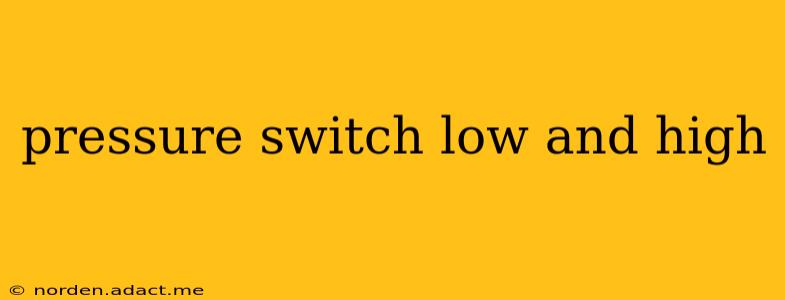Pressure switches are essential components in various systems, from water pumps to air compressors, controlling the operation based on pressure levels. Understanding how these switches function, particularly their low and high pressure settings, is crucial for maintaining efficient and safe operation. This guide will delve into the intricacies of pressure switches, explaining their functionality, troubleshooting common issues, and providing practical tips for optimal performance.
What is a Pressure Switch?
A pressure switch is a simple yet vital electromechanical device that acts as a pressure sensor and a switch. It monitors the pressure within a system and automatically turns a connected device on or off based on predetermined pressure thresholds. These thresholds are adjustable, allowing for customization depending on the specific application. When the pressure reaches the lower set point, the switch closes, activating the device (e.g., starting a pump). When the pressure reaches the higher set point, the switch opens, deactivating the device (e.g., stopping the pump).
How Does a Pressure Switch Work?
The core mechanism of a pressure switch relies on a diaphragm or a piston that responds to changes in pressure. This diaphragm or piston is mechanically linked to a set of contacts. When the pressure increases, it pushes against the diaphragm/piston, causing the contacts to close and complete an electrical circuit. Conversely, when the pressure decreases, the diaphragm/piston retracts, breaking the circuit and turning the device off. The pressure at which these actions occur is determined by the adjustable settings on the switch itself.
Understanding Low and High Pressure Settings
The two primary adjustable settings on a pressure switch are the low pressure cut-in and the high pressure cut-out.
-
Low Pressure Cut-in (or Cut-in Pressure): This is the pressure level at which the switch closes, initiating the operation of the connected device. For example, in a water pump system, this is the pressure at which the pump starts pumping water. A lower cut-in pressure means the pump will start sooner, while a higher cut-in pressure means the pump will start later.
-
High Pressure Cut-out (or Cut-out Pressure): This is the pressure level at which the switch opens, stopping the operation of the connected device. In the same water pump example, this is the pressure at which the pump stops pumping water. A higher cut-out pressure means the pump will run longer and build up more pressure before stopping, while a lower cut-out pressure will result in shorter pump cycles.
What Happens if the Pressure Switch is Set Too Low?
Setting the low pressure cut-in too low might lead to frequent cycling of the pump or compressor. This can cause premature wear and tear on the equipment, reducing its lifespan and potentially leading to increased energy consumption.
What Happens if the Pressure Switch is Set Too High?
Conversely, setting the high pressure cut-out too high can result in excessively high pressure within the system, potentially damaging components or creating safety hazards.
How to Adjust Pressure Switch Settings?
Adjusting pressure switch settings typically involves turning two adjustment screws on the switch itself. Consult the specific instructions for your pressure switch model, as adjustment methods can vary. Improper adjustments can damage the switch or the connected equipment; careful attention to the instructions is vital.
Troubleshooting Common Pressure Switch Problems
-
Pump runs constantly: This often indicates a problem with the high-pressure cut-out setting, a faulty pressure switch, or a leak in the system.
-
Pump doesn't start: This might be due to a low-pressure cut-in setting that's too high, a faulty pressure switch, or a problem with the power supply or the pump itself.
-
Inconsistent pressure: Inconsistent pressure might indicate a problem with the pressure switch, a leak in the system, or a faulty pressure gauge.
Choosing the Right Pressure Switch
Selecting the appropriate pressure switch requires careful consideration of the specific application and the operating pressure range of the system. Always ensure that the pressure switch is rated for the appropriate pressure and voltage.
This comprehensive guide provides a detailed overview of pressure switches, addressing common concerns and offering practical advice for maintaining optimal performance. Remember to always consult the manufacturer's instructions for your specific model.
